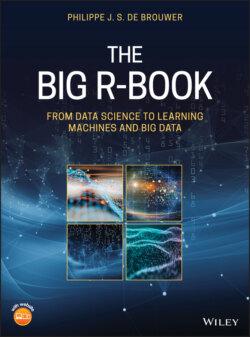Читать книгу The Big R-Book - Philippe J. S. De Brouwer - Страница 33
♣4♣ The Basics of R
ОглавлениеIn this book we will approach data and analytics from a practitioners point of view and our tool of choice is R. R is in some sense a re-implementation of S – a programming language written in 1976 by John Chambers at Bell Labs – with added lexical scoping semantics. Usually, codewritten in S will also run in R.
S
R is a modern language with a rather short history. In 1992, the R-project was started by Ross Ihaka and Robert Gentleman at the University of Auckland, New Zealand. The first version was available in 1995 and the first stable version was available in 2000.
Now, the R Development Core Team (of which Chambers is a member) develops R further and maintains the code. Since a few years Microsoft has embraced the project and provides MRAN (Microsoft R Application Network). This package is also free and open source software (FOSS) and has some advantages over standard R such as enhanced performance (e.g. multi-thread support, the checkpoint package that makes results more reproducible).
FOSS
Essentially, R is …
a programming language built for statistical analysis, graphics representation and reporting;
an interpreted computer language which allows branching, looping, modular programming as well as object and functional oriented programming features.
R offers its users …
integration with the procedures written in the C, C++, .Net, Python, or FORTRAN languages for efficiency;
C
C++
.Net
Fortran
zero purchase cost (available under the GNU General Public License), and pre-compiled binary versions are provided for various operating systems like Linux, Windows, and Mac;
Linux
Windows
Mac
simplicity and effectiveness;
a free and open environment;
an effective data handling and storage facility;
a suite of operators for calculations on arrays, lists, vectors, and matrices;
a large, coherent, and integrated collection of tools for data analysis;
graphical facilities for data analysis and display either directly at the computer or printing;
a supportive on-line community;
the ability for you to stand on the shoulders of giants (e.g. by using libraries).
R is arguably the most widely used statistics programming language and is used fromuniversities to business applications, while it still gains rapidly in popularity.
